Plot summary
The novel deals with the significance of two connected events that happened on the same day, long before the opening of the novel. The first was the excavation of an ancient and valuable archaeological idol, a phallic figure unearthed from the tomb of an Anglo-Saxon bishop Eorpwald, known as the "Melpham excavation". Gerald has long been haunted by a drunken revelation by his friend Gilbert, who was involved with this excavation, that the whole thing was a hoax perpetrated to embarrass Gilbert's father. Gilbert told Gerald that he put the idol there. Gerald, while feeling that his friend was telling the truth, pushed the matter to the back of his mind and tried to forget about it. He now feels ashamed that he, a history professor, has never had the courage to try to resolve the matter one way or another.
The second is that Gerald Middleton fell in love with Dollie, Gilbert's fiancée, and had an affair with her when his friend went off to fight in World War I. When Gilbert was killed at the front, Dollie refused to marry Gerald. He ended up marrying a Scandinavian woman named Inge but continued his affair with Dollie, who became an alcoholic. Gerald and Inge later separated.
Anglo-Saxon Attitudes is full of side-plots and coincidences and contains a host of eccentric characters. Some of these characters are Gerald's family. Robin, his eldest son, is a womaniser who cannot decide whether to leave his wife or his mistress. Kay has an unhappy marriage and a deeply embittered view of her father, whom she appears to blame for everything that has gone wrong in her life, including her withered hand (which was actually caused by her mother). Gerald's estranged wife, Inge, is a grotesquely deluded woman who cannot bring herself to acknowledge her younger son John's homosexuality or her daughter's physical disability.
Gerald feels responsible for Dollie's plight and for those of his children. He feels that the knowledge of his complicity over the Melpham affair has drained his morale and made him withdrawn and indecisive. The novel begins with him resolving to make good the 'bloody shameful waste' of his life, by investigating the Melpham affair and making peace with Dollie. He also attempts to develop better relationships with his grown-up children and with Inge.
By the novel's end, Gerald achieves a measure of peace with his past. He persuades Dollie to come forward with a letter from Gilbert's father's colleague, Canon Portway, proving that the Melpham incident was a hoax; then he and Dollie begin a platonic friendship. He gives up on achieving good relations with his family.

Rædwald, also written as Raedwald or Redwald, was a king of East Anglia, an Anglo-Saxon kingdom which included the present-day English counties of Norfolk and Suffolk. He was the son of Tytila of East Anglia and a member of the Wuffingas dynasty, who were the first kings of the East Angles. Details about Rædwald's reign are scarce, primarily because the Viking invasions of the 9th century destroyed the monasteries in East Anglia where many documents would have been kept. Rædwald reigned from about 599 until his death around 624, initially under the overlordship of Æthelberht of Kent. In 616, as a result of fighting the Battle of the River Idle and defeating Æthelfrith of Northumbria, he was able to install Edwin, who was acquiescent to his authority, as the new king of Northumbria. During the battle, both Æthelfrith and Rædwald's son, Rægenhere, were killed.

Sutton Hoo is the site of two Anglo-Saxon cemeteries dating from the 6th to 7th centuries near Woodbridge, Suffolk, England. Archaeologists have been excavating the area since 1938, when an undisturbed ship burial containing a wealth of Anglo-Saxon artifacts was discovered. The site is important in establishing the history of the Anglo-Saxon kingdom of East Anglia as well as illuminating the Anglo-Saxons during a period which lacks historical documentation.

Sir Angus Frank Johnstone-Wilson, CBE was an English novelist and short story writer. He was one of England's first openly gay authors. He was awarded the 1958 James Tait Black Memorial Prize for The Middle Age of Mrs Eliot and later received a knighthood for his services to literature.
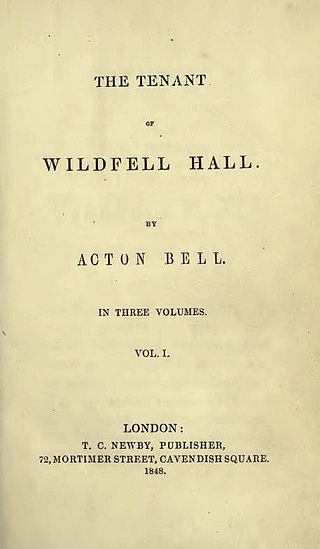
The Tenant of Wildfell Hall is the second and final novel written by English author Anne Brontë. It was first published in 1848 under the pseudonym Acton Bell. Probably the most shocking of the Brontës' novels, it had an instant and phenomenal success, but after Anne's death her sister Charlotte prevented its re-publication in England until 1854.

Ellen Anderson Gholson Glasgow was an American novelist who won the Pulitzer Prize for the Novel in 1942 for her novel In This Our Life. She published 20 novels, as well as short stories, to critical acclaim. A lifelong Virginian, Glasgow portrayed the changing world of the contemporary South in a realistic manner, differing from the idealistic escapism that characterized Southern literature after Reconstruction.
Æthelhere was King of East Anglia from 653 or 654 until his death. He was a member of the ruling Wuffingas dynasty and one of three sons of Eni to rule East Anglia as Christian kings. He was a nephew of Rædwald, who was the first of the Wuffingas of which more than a name is known.
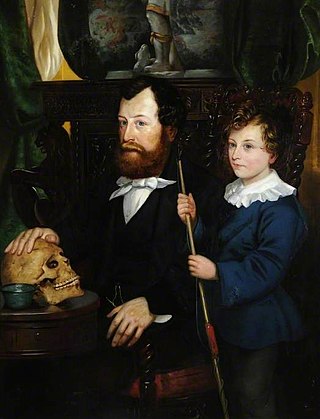
Thomas Bateman was an English antiquary and barrow-digger.
The Prittlewell royal Anglo-Saxon burial or Prittlewell princely burial is a high-status Anglo-Saxon burial mound which was excavated at Prittlewell, north of Southend-on-Sea, in the English county of Essex.

The Alfred Jewel is a piece of Anglo-Saxon goldsmithing work made of enamel and quartz enclosed in gold. It was discovered in 1693, in North Petherton, Somerset, England and is now one of the most popular exhibits at the Ashmolean Museum in Oxford. It has been dated to the late 9th century, in the reign of Alfred the Great, and is inscribed "AELFRED MEC HEHT GEWYRCAN", meaning "Alfred ordered me made". The jewel was once attached to a rod, probably of wood, at its base. After decades of scholarly discussion, it is now "generally accepted" that the jewel's function was to be the handle for a pointer stick for following words when reading a book. It is an exceptional and unusual example of Anglo-Saxon jewellery.

Richard de Clare, 2nd Earl of Pembroke, also Lord of Leinster and Justiciar of Ireland, was an Anglo-Norman nobleman notable for his leading role in the Anglo-Norman invasion of Ireland. Like his father, Richard is commonly known by his nickname, Strongbow.

John Middleton Murry was an English writer. He was a prolific author, producing more than 60 books and thousands of essays and reviews on literature, social issues, politics, and religion during his lifetime. A prominent critic, Murry is best remembered for his association with Katherine Mansfield, whom he married in 1918 as her second husband, for his friendship with D. H. Lawrence and T. S. Eliot, and for his friendship with Frieda Lawrence. Following Mansfield's death, Murry edited her work.
Ecgric was a king of East Anglia, the independent Anglo-Saxon kingdom that today includes the English counties of Norfolk and Suffolk. He was a member of the ruling Wuffingas dynasty, but his relationship with other known members of the dynasty is not known with any certainty. Anna of East Anglia may have been his brother, or his cousin. It has also been suggested that he was identical with Æthelric, who married the Northumbrian princess Hereswith and was the father of Ealdwulf of East Anglia. The primary source for the little that is known about Ecgric's life is Historia ecclesiastica gentis Anglorum, written by the English Benedictine monk Bede in around 731 AD.
Sigeberht of East Anglia, was a saint and a king of East Anglia, the Anglo-Saxon kingdom which today includes the English counties of Norfolk and Suffolk. He was the first English king to receive a Christian baptism and education before his succession and the first to abdicate in order to enter the monastic life. The principal source for Sigeberht is Bede's Ecclesiastical History of the English People, which was completed in the 730s.
Ricberht, may have briefly ruled East Anglia, a small independent Anglo-Saxon kingdom which today forms the English counties of Norfolk and Suffolk. Little is known of his life or his reign.

Eynsford Castle is a ruined medieval fortification in Eynsford, Kent. Built on the site of an earlier Anglo-Saxon stone burh, the castle was constructed by William de Eynsford, probably between 1085 and 1087, to protect the lands of Lanfranc, the Archbishop of Canterbury, from Odo, the Bishop of Bayeux. It comprised an inner and an outer bailey, the former protected by a stone curtain wall. In 1130 the defences were improved, and a large stone hall built in the inner bailey. The de Eynsford family held the castle until their male line died out in 1261, when it was divided equally between the Heringaud and de Criol families. A royal judge, William Inge, purchased half of the castle in 1307, and arguments ensued between him and his co-owner, Nicholas de Criol, who ransacked Eynsford in 1312. The castle was never reoccupied and fell into ruins, and in the 18th century it was used to hold hunting kennels and stables. The ruins began to be restored after 1897, work intensifying after 1948 when the Ministry of Works took over the running of the castle. In the 21st century, Eynsford Castle is managed by English Heritage and is open to visitors.
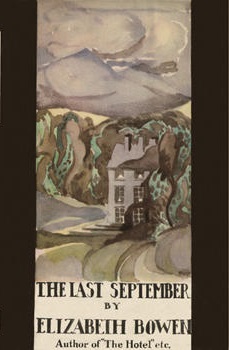
The Last September is a 1929 novel by the Anglo-Irish writer Elizabeth Bowen, concerning life in Danielstown, Cork during the Irish War of Independence, at a country mansion. John Banville wrote a screenplay based on the novel; the film adaptation was released in 1999.

The Dig is a historical novel by John Preston, published in May 2007, set in the context of the 1939 Anglo-Saxon ship burial excavation at Sutton Hoo, Suffolk, England. The dust jacket describes it as "a brilliantly realized account of the most famous archaeological dig in Britain in modern times".
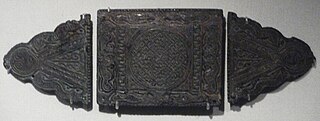
Mucking is an archaeological site near the village of Mucking in southern Essex. The site contains remains dating from the Neolithic to the Middle Ages—a period of some 3,000 years—and the Bronze Age and Anglo-Saxon features are particularly notable.
Witchcraft in Anglo-Saxon England refers to the belief and practice of magic by the Anglo-Saxons between the 5th and 11th centuries AD in Early Mediaeval England. Surviving evidence regarding Anglo-Saxon witchcraft beliefs comes primarily from the latter part of this period, after England had been Christianised. This Christian era evidence includes penitentials, pastoral letters, homilies and hagiographies, in all of which Christian preachers denounce the practice of witchcraft as un-Christian, as well as both secular and ecclesiastical law codes, which mark it out as a criminal offence.
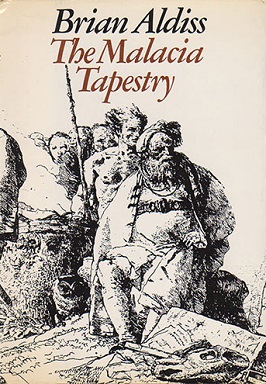
The Malacia Tapestry is a fantasy-historical novel by British writer Brian Aldiss, published in 1976. The story takes place in a fictional port city called Malacia, which is an alternate history version of a Renaissance city-state. It tells the story of a poor young actor named Perian de Chirolo who hopes to change his station in life so he can marry a wealthy merchant's daughter. While Malacia is considered a near-utopia, the happiness in the city belies the authoritarian rule of the powerful Supreme Council, which uses fear to prevent progress.














